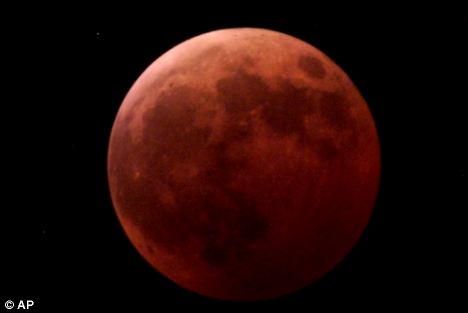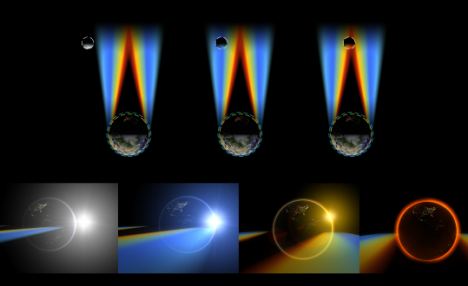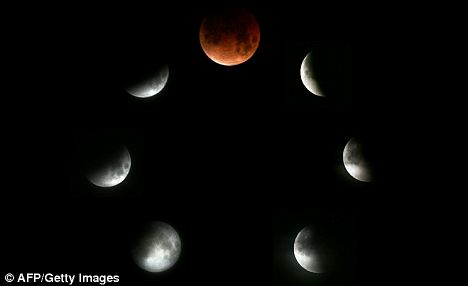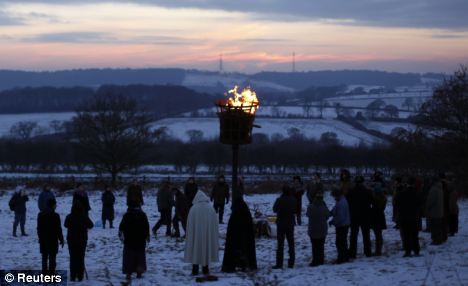Babylon
JF-Expert Member
- Feb 5, 2009
- 1,332
- 82
Total lunar eclipse coincides with Winter Solstice for first time in almost 400 years
Last updated at 7:17 PM on 20th December 2010
A total lunar eclipse is set to the turn the sky a deep red tomorrow morning as it coincides with the darkest day of the year for the first time in almost 400 years.
The full moon will start to pass through Earth's shadow at 6.32am on the shortest day of the year, the Winter Solstice on December 21.
According to NASA, the last time a total lunar eclipse coincided with the winter solstice was December 21, 1638 making tomorrow morning the darkest in almost 400 years.
 Earth's shadow will appear as a dark-red bite at the edge of the lunar disk. It takes about an hour for the 'bite' to expand and swallow the entire moon
Earth's shadow will appear as a dark-red bite at the edge of the lunar disk. It takes about an hour for the 'bite' to expand and swallow the entire moon
The next one will be December 21, 2094.
Unusually, this eclipse will include a brief period when both the sun and eclipsed moon are above the horizon and appear precisely opposite each other in the sky known as a selenehelion.
ONCE IN A BLUE MOON...
The entire eclipse will be visible from North America, the eastern Pacific and the northwest of South America.
From western Europe, including the UK and Ireland, the moon will set during the eclipse as the sun rises.
From southern parts of the UK, the initial partial phase and the beginning of totality will be visible, but the moon will drop into the western sky as dawn approaches.
From locations in Scotland and Northern Ireland, totality will be visible in its entirety, but the moon will be low down after the time of greatest eclipse.
The partial eclipse begins when the moon first enters the dark inner, umbral part of the Earth's shadow, and will become a total eclipse at 7.40am.
The moon is full but moves into the shadow of the Earth and dims dramatically with the shadowed lunar surface lit by sunlight that passes through the Earth's atmosphere.
Stronger atmospheric scattering of blue light means that the light that reaches the lunar surface tends to have a reddish hue, so observers on Earth will see a moon that is much darker than usual, withe the sky burning a deep red colour.
The eclipse will reach its maximum at 8.17am, and end at 8.53am.
The moon travels to a similar position every month, but the tilt of the lunar orbit means that it normally passes above or below the terrestrial shadow. A full moon is seen but no eclipse takes place.
Lunar eclipses are visible wherever the moon is above the horizon.
 A diagram which shows how the light refracting around the Earth's edge can make the moon appear blood red during an eclipse
A diagram which shows how the light refracting around the Earth's edge can make the moon appear blood red during an eclipse
 A lunar eclipse on February 21, 2008 showing various stages of the lunar eclipse as seen in Sofia
A lunar eclipse on February 21, 2008 showing various stages of the lunar eclipse as seen in Sofia
This time the entire eclipse will be visible from the whole of North America, the eastern Pacific and the northwest of South America.
From western Europe, including the UK and Ireland, the moon will set during the eclipse as the sun rises.
From southern parts of the UK, the initial partial phase and the beginning of what is known as 'totality' will be visible, but the moon will be dropping down into the western sky as dawn approaches.
From those locations, when totality begins, the moon will be very low in the west-north-western sky, close to the horizon and in a rapidly brightening sky.
From locations in Scotland and Northern Ireland, totality will be visible in its entirety, but the moon will be low down after the time of greatest eclipse.
During totality the moon tracks through the northern part of the Earth's dark umbral shadow, so the southern half will appear considerably darker than the northern part.
 Druids gather for a winter solstice ritual to mark the shortest day's sunlight on Beacon Hill near Loughborough yesterday
Druids gather for a winter solstice ritual to mark the shortest day's sunlight on Beacon Hill near Loughborough yesterday
John Mason, from the British Astronomical Association, said: 'Observers should go out at about 6.30am when, if the sky is clear, the moon will be visible in the western sky, and they will be able to watch as more and more of the southern part of the moon becomes immersed in the Earth's shadow.
'They can continue watching until the eclipse becomes total at 7.40am, and hopefully for a little while after this time, if they have an unobstructed western horizon.'
The brightness of the eclipse depends on the conditions in the Earth's upper atmosphere through which all light falling on to the shadowed moon has to pass.
Dr Mason added: 'For observers in the British Isles, the very low elevation of the moon during the total phase means that it is not possible to predict just how dark the moon will be when it is eclipsed, or what colour it will appear.
'One will just have to go out and have a look.'
Last updated at 7:17 PM on 20th December 2010
A total lunar eclipse is set to the turn the sky a deep red tomorrow morning as it coincides with the darkest day of the year for the first time in almost 400 years.
The full moon will start to pass through Earth's shadow at 6.32am on the shortest day of the year, the Winter Solstice on December 21.
According to NASA, the last time a total lunar eclipse coincided with the winter solstice was December 21, 1638 making tomorrow morning the darkest in almost 400 years.

The next one will be December 21, 2094.
Unusually, this eclipse will include a brief period when both the sun and eclipsed moon are above the horizon and appear precisely opposite each other in the sky known as a selenehelion.
ONCE IN A BLUE MOON...
The entire eclipse will be visible from North America, the eastern Pacific and the northwest of South America.
From western Europe, including the UK and Ireland, the moon will set during the eclipse as the sun rises.
From southern parts of the UK, the initial partial phase and the beginning of totality will be visible, but the moon will drop into the western sky as dawn approaches.
From locations in Scotland and Northern Ireland, totality will be visible in its entirety, but the moon will be low down after the time of greatest eclipse.
The partial eclipse begins when the moon first enters the dark inner, umbral part of the Earth's shadow, and will become a total eclipse at 7.40am.
The moon is full but moves into the shadow of the Earth and dims dramatically with the shadowed lunar surface lit by sunlight that passes through the Earth's atmosphere.
Stronger atmospheric scattering of blue light means that the light that reaches the lunar surface tends to have a reddish hue, so observers on Earth will see a moon that is much darker than usual, withe the sky burning a deep red colour.
The eclipse will reach its maximum at 8.17am, and end at 8.53am.
The moon travels to a similar position every month, but the tilt of the lunar orbit means that it normally passes above or below the terrestrial shadow. A full moon is seen but no eclipse takes place.
Lunar eclipses are visible wherever the moon is above the horizon.


This time the entire eclipse will be visible from the whole of North America, the eastern Pacific and the northwest of South America.
From western Europe, including the UK and Ireland, the moon will set during the eclipse as the sun rises.
From southern parts of the UK, the initial partial phase and the beginning of what is known as 'totality' will be visible, but the moon will be dropping down into the western sky as dawn approaches.
From those locations, when totality begins, the moon will be very low in the west-north-western sky, close to the horizon and in a rapidly brightening sky.
From locations in Scotland and Northern Ireland, totality will be visible in its entirety, but the moon will be low down after the time of greatest eclipse.
During totality the moon tracks through the northern part of the Earth's dark umbral shadow, so the southern half will appear considerably darker than the northern part.

John Mason, from the British Astronomical Association, said: 'Observers should go out at about 6.30am when, if the sky is clear, the moon will be visible in the western sky, and they will be able to watch as more and more of the southern part of the moon becomes immersed in the Earth's shadow.
'They can continue watching until the eclipse becomes total at 7.40am, and hopefully for a little while after this time, if they have an unobstructed western horizon.'
The brightness of the eclipse depends on the conditions in the Earth's upper atmosphere through which all light falling on to the shadowed moon has to pass.
Dr Mason added: 'For observers in the British Isles, the very low elevation of the moon during the total phase means that it is not possible to predict just how dark the moon will be when it is eclipsed, or what colour it will appear.
'One will just have to go out and have a look.'